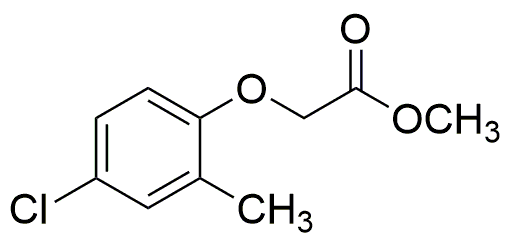Methyl 4-chloro-2-methylphenoxyacetate is widely utilized in research focused on:
- Agricultural Chemicals: This compound serves as an effective herbicide, helping farmers control unwanted vegetation while promoting crop health. Its selective action minimizes damage to desirable plants, making it a valuable tool in sustainable agriculture.
- Pharmaceutical Development: In medicinal chemistry, it is used as an intermediate in the synthesis of various pharmaceutical compounds, aiding researchers in developing new drugs with improved efficacy and safety profiles.
- Biochemical Research: The compound is employed in studies related to enzyme inhibition and receptor binding, providing insights into biochemical pathways and potential therapeutic targets.
- Material Science: It finds applications in the formulation of specialty coatings and polymers, enhancing properties such as durability and resistance to environmental factors.
- Environmental Studies: Researchers utilize this compound to assess its impact on ecosystems, contributing to the understanding of chemical behavior in soil and water, which is crucial for environmental protection efforts.
Informations générales
Propriétés
Sécurité et réglementation
Applications
Methyl 4-chloro-2-methylphenoxyacetate is widely utilized in research focused on:
- Agricultural Chemicals: This compound serves as an effective herbicide, helping farmers control unwanted vegetation while promoting crop health. Its selective action minimizes damage to desirable plants, making it a valuable tool in sustainable agriculture.
- Pharmaceutical Development: In medicinal chemistry, it is used as an intermediate in the synthesis of various pharmaceutical compounds, aiding researchers in developing new drugs with improved efficacy and safety profiles.
- Biochemical Research: The compound is employed in studies related to enzyme inhibition and receptor binding, providing insights into biochemical pathways and potential therapeutic targets.
- Material Science: It finds applications in the formulation of specialty coatings and polymers, enhancing properties such as durability and resistance to environmental factors.
- Environmental Studies: Researchers utilize this compound to assess its impact on ecosystems, contributing to the understanding of chemical behavior in soil and water, which is crucial for environmental protection efforts.
Documents
Fiches de données de sécurité (FDS)
La FDS fournit des informations de sécurité complètes sur la manipulation, le stockage et l’élimination du produit.
Spécifications du produit (PS)
Le PS fournit une description complète des propriétés du produit, notamment sa composition chimique, son état physique, sa pureté et les exigences de stockage. Il détaille également les plages de qualité acceptables et les applications prévues du produit.
Certificats d'analyse (COA)
Recherchez des certificats d'analyse (COA) en saisissant le numéro de lot du produit. Les numéros de lot et de lot se trouvent sur l'étiquette d'un produit, après les mots « Lot » ou « Lot de fabrication ».
Numéro de catalogue
Numéro de lot/série
Certificats d'origine (COO)
Ce certificat d'exploitation confirme le pays dans lequel le produit a été fabriqué, et détaille également les matériaux et composants utilisés et s'il est issu de sources naturelles, synthétiques ou autres sources spécifiques. Ce certificat peut être requis pour les douanes, le commerce et la conformité réglementaire.
Numéro de catalogue
Numéro de lot/série
Fiches de données de sécurité (FDS)
La FDS fournit des informations de sécurité complètes sur la manipulation, le stockage et l’élimination du produit.
DownloadSpécifications du produit (PS)
Le PS fournit une description complète des propriétés du produit, notamment sa composition chimique, son état physique, sa pureté et les exigences de stockage. Il détaille également les plages de qualité acceptables et les applications prévues du produit.
DownloadCertificats d'analyse (COA)
Recherchez des certificats d'analyse (COA) en saisissant le numéro de lot du produit. Les numéros de lot et de lot se trouvent sur l'étiquette d'un produit, après les mots « Lot » ou « Lot de fabrication ».
Numéro de catalogue
Numéro de lot/série
Certificats d'origine (COO)
Ce certificat d'exploitation confirme le pays dans lequel le produit a été fabriqué, et détaille également les matériaux et composants utilisés et s'il est issu de sources naturelles, synthétiques ou autres sources spécifiques. Ce certificat peut être requis pour les douanes, le commerce et la conformité réglementaire.


